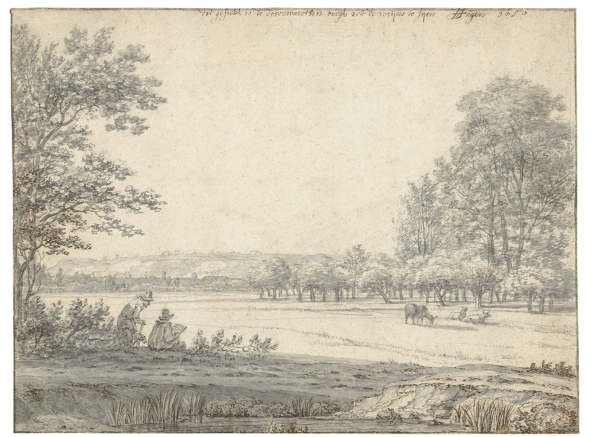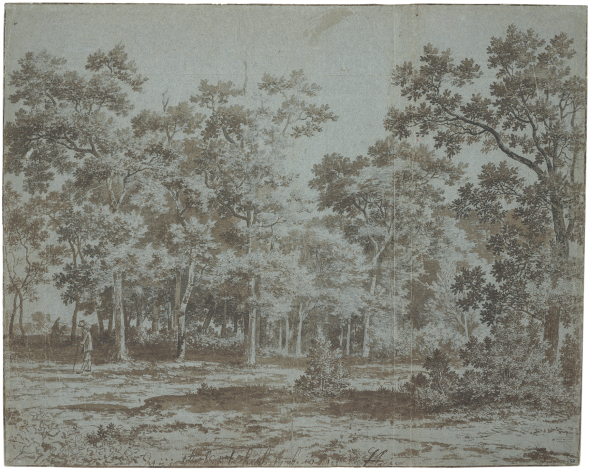Choose a background colour
Joris van der Haagen, Dutch, c. 1615-1669: View in the Hague Woods (“Haagse Bos”), c. 1660
Pen and gray and brown inks with gray wash over black chalk on paper; framing lines in black ink.
7 13⁄16 × 12 5⁄16 in. (19.9 × 31.3 cm)
Recto, lower left, pen in brown ink, inscribed by the artist and signed, dit is int haachse bos nomb…[“this is in the Haagse Bos, number…” with illegible numeral] JVHagen; on the mount, pen in brown ink, in an early hand (eighteenth or nineteenth century), J.F. — L.v.L. No.42.
- Chain Lines:
- Horizontal, 24 – 25 mm.
- Watermark:
- None.
- Provenance:
Unidentified collector, eighteenth or nineteenth century (inscription on mount); dealer, H. D. Pfann, Amsterdam, 1956; Hans van Leeuwen, 1911 – 2010, Amerongen (Lugt 2799a, stamp on verso of mount); his sale, Christie’s, Amsterdam, 24 November 1992, lot 96; Sheldon and Leena Peck, Boston (Lugt 3847); gift to the Ackland Art Museum, inv. no. 2017.1.42.
- Literature/Exhibitions:
Arnhem 1958, no. 46; Utrecht 1959 – 60, no. 25; Laren 1963, no. 51; Nijmegen 1965, no. 26; Leeuwarden 1966, no. 12; Boon, Saarbrücken & Bochum 1968 – 69, no. 55; Rheydt 1971, no. 32; Amsterdam 1975– 76, no. 51; Bremen, Braunschweig & Stuttgart 1979 – 80, no. 52; Fribourg, Passau, Trier, Aachen & Nuremburg 1982 – 84, no. 40; Brandt 1986, no. 14; F. Robinson in Chapel Hill, Ithaca & Worcester 1999 – 2001, 62 – 63, no. 15.
- Ackland Catalogue:
- 2017.1.42
Using a variety of drawing media and stylistic techniques, Joris van der Haagen emphasized the towering beauty of old-growth trees and lush foliage, their impressive scale underscored by the hunter and dog visible through the tall grasses in the foreground. Aside from occasional travel, the artist spent his entire career in The Hague and drew the large and stately forest of the Haagse Bos (Hague Woods) on a regular basis. The significance of these woods, aside from their visually rich appearance, rests in their history. Nearly destroyed for its timber early in the Eighty Years’ War (1568-1648), a law passed in 1576 permanently preserved the wooded park, a critical initiative that allowed parts of the land to remain accessible to visitors up to the present day.
According to his signed inscription at the bottom of the sheet, Joris van der Haagen drew this study in the beautifully preserved woods just northeast of The Hague known as the “Haagse Bos” (Hague Woods). The park is best known for housing the palace Huis ten Bosch, built in 1645 – 52, that contains a notable cycle of paintings by various Dutch and Flemish artists in its famous Oranjezaal. The palace today serves as the residence of the Dutch royal family, though much of the park is still publicly accessible.
The woods would have been a short walk for Van der Haagen from his home in The Hague city center, where he lived for his entire career. He joined the guild there in 1643, served as headman in 1653, and in 1656 became one of the cofounders of the new fi né arts guild called the Confrerie Pictura.1
Although he traveled quite frequently, producing a number of labeled or topographically identifiable views of sites along the Rhine River and other regions in the Netherlands and Germany, the Haagse Bos proved to be his favorite subject closer to home. At least two dozen of his drawings appear to be set in the woods, around half of which are labeled as such by his own hand.2
Some of these drawings served as studies for his landscape paintings.3
He appears to have kept many of his landscape drawings in his studio until the end of his life.4
Van der Haagen’s full powers as a draftsman are on display in this sheet. His rendering of the dappling effects of sunlight and movement in the foliage are particularly distinctive. Arnold Houbraken (1660 – 1719) was a great admirer of Van der Haagen’s landscape drawings, describing their “marvelously spirited” manner, and noting they achieved high prices at auction in 1715.5
In the Peck drawing, Van der Haagen enhanced the richness of his foliage effects through a variety of pen and brush techniques that combine deftly to define textures and spatial zones. The brown ink applied with a pen, seen in the large tree that dominates the middle of the image, effectively pulls that tree outward from the others. He probably used an iron-gall ink for these highlights, seen also in the hedges and marshy grass in the foreground, which may have been darker or blacker when originally applied. He also added dark accents with what appears to be an oiled black chalk in places, seen especially in the small tree in the lower right corner. This meticulous combination of media creates a lavish sense of the woods as a visually rich subject.6
Van der Haagen’s drawn oeuvre has not yet yielded a clear stylistic development to aid in the dating of his works, with the exception of a handful of sheets from early in his career.7 A date around 1650 for the Peck drawing can be cautiously posited based on comparable pen work in the foliage and marshy grass in a drawing of Doorwerth (near Arnhem) bearing a date of that year Fig. 33.1.8

Joris van der Haagen, Doorwerth, 1650. Pen and brown ink, with gray wash over black chalk, 195 × 259 mm. Amsterdam, Rijksmuseum, inv. no. rp-t-1884-a-342.
Rijksmuseum, Amsterdam
If indeed from around 1650, the Peck drawing would be one of Van der Haagen’s earliest known depictions of the Haagse Bos, along with a large wooded scene in black chalk on blue paper from the 1640s in the Fondation Custodia, Paris Fig. 33.2. 9

Joris van der Haagen, View of the Haagse Bos, probably 1644 or 1647. Black chalk and gray wash on blue paper, 570 × 455 mm. Paris, Fondation Custodia, Collection Frits Lugt, inv. no. 9043.
Fondation Custodia, Collection Frits Lugt, Paris
Other labeled drawings of the Haagse Bos span the remainder of his career, with sheets dated between 1653 and 1669.10
He drew the majority of these in black chalk on blue paper, with pen drawings like this one being less common.
The inscriptions that populate a number of Van der Haagen’s drawings still hold some mysteries. There is good reason to think that most of them were applied at the same moment years later since so many appear to match closely in terms of orthography, ink, and placement at the bottom of the sheet.11
The latest of these is dated 1669, the year of his death, and it is possible that most were added around that time, including the one on the present sheet.12
Many of his drawings appear to have had their inscriptions trimmed away early in their history since they were probably considered a nuisance by eighteenth-century collectors and dealers, but some sheets still have slight traces of the tops of the cropped inscriptions beneath new framing lines. The inscriptions reveal that Van der Haagen had some sort of numbering system: digits following the word nomber or an abbreviation meaning the same. The word nomb… appears on the present sheet though the number itself is no longer visible, the artist having written over it with his signature, JVHagen, as is the case on certain other drawings as well. The visible numbers on other sheets run as high as 190, which is not surprising given that around 250 drawings by the artist are estimated to survive today.13
The special appeal of these woods for Van der Haagen was not just due to their proximity to the city where he lived. The Haagse Bos was nearly destroyed during the Eighty Years’ War (1568 – 1648) when the States of Holland decided to sell its valuable timber in order to pay for mercenaries. In 1576, William the Silent (1533 – 1584) signed the Act of Redemption to permanently preserve the woods, a document that remains significant for the city. The act also prevented common people from entering the forest to make use of its natural resources, a rule which a warden was hired to enforce.14
The Haagse Bos therefore offered an exceptionally well-maintained and enclosed Arcadian-like paradise for artists such as Van der Haagen, with its beautiful old-growth trees and plentiful game. It provided an idealized yet naturally existing form of landscape.
Amalia van Solms (1602 – 1675), wife of the Stadhouder Frederik Hendrik (1584 – 1647), began overseeing the building of the Huis ten Bosch at the eastern end of the woods in 1645.15
After its completion in 1652, the building featured in a number of Van der Haagen’s paintings, as did a number of other buildings by its architect, Pieter Post (1608 – 1669), who was likely a close friend of the artist.16
The Haagse Bos became, in effect, a park and game preserve restricted to the use of the Stadhouder’s court and guests, many of whom would have enjoyed wandering or indeed hunting there, as one sees in the foreground. Van der Haagen would have almost certainly needed special permission to enter the woods, a granting of access that likely indicates good connections at court.
End Notes
For Van der Haagen’s biography, see especially Buijsen et al. 1998, 146 – 49; and Van der Haagen 1932. For the founding and significance of the Confrerie Pictura, see Bakker 2019.
Van der Haagen 1932, 83 – 88, nos. 68 – 72, 77 – 98. This estimate includes drawings labeled “Koekamp,” the western end of the woods intersecting the city but likewise enclosed. As Van der Haagen (a descendant of the artist) noted in his catalogue raisonné, an exact number of Haagse Bos drawings is difficult to ascertain since a number of them listed in early auction catalogues might repeat those he already listed. The artist made some paintings of the Haagse Bos, usually with the Huis ten Bosch in the background; idem, 84 – 85, nos. 73 – 76.
For examples of drawings of woodland views that were used for his paintings, see Plomp 1997, 176 – 78, nos. 178 – 79.
This supposition is based on the evidence that he added many of the inscriptions in the final year of his life, to be discussed further below; Van der Haagen 1932, 25 – 26.
Houbraken 1718 – 21, vol. 3, 203. One wonders if the notable group of drawings that appeared at auction in 1715 came from the estate of the artist’s son, Jacobus van der Haagen (1657 – 1715), also an artist.
With thanks to the conservators Reba Snyder and Grace White for examining the media closely
For the early drawings, which reveal a debt to Haarlem artists of the previous generation such as Esaias van de Velde, see Robinson 1990; Robinson 2000; and Robinson 2015.
Amsterdam, Rijksmuseum, inv. no. rp-t-1884-a-342; Schapelhouman & Schatborn 1987, 72 – 73; and Schatborn in Washington & Paris 2016 – 17, no. 1.
The last digit has been variously read, but thought to be either a 4 or 7, and the year therefore as 1644 or 1647; see Carlos van Hasselt in Brussels, Rotterdam, Paris, & Bern 1968 – 69, no. 72.
Aside from the aforementioned sheet in the Fondation Custodia (note 9, above), dated drawings of the Haagse Bos include: Amsterdam, Rijkmuseum, inv. no. RP-T-1884-A-343, dated 1653; Vienna, Albertina, inv. no. 15132, dated 1658 (see Marian Bisanz-Prakken in Milwaukee 2005 – 06, no. 76); Haarlem, Teylers Museum, inv. no. U 23, dated 1662 (see Plomp 1997, no. 178; and Kersten in New York & Chicago 1989, no. 90); Weimar, dated 1665 (Van der Haagen 1932, no. 82); Amsterdam, Fodor Collection, Amsterdam Museum, inv. no. A 10186, dated 1668 (see Broos & Schapelhouman 1993, no. 65; and Duparc in Cambridge & Montréal 1988, no. 40); and Frankfurt, Städel Museum, dated 1669 (Van der Haagen 1932, no. 79).
For a discussion of this issue, see Van der Haagen 1932, 25 – 26.
The sheet dated 1669 in Frankfurt (as per note 10 above). Before dying on May 20, 1669, there is some evidence that the artist suffered a long illness, since he was listed as “indisposed” a few months earlier by the local civic guard, of which he was a member; see Buijsen et al. 1998, 149.
Van der Haagen 1932, 145.
Smit 1922, 274 – 80.
For the history of the Huis ten Bosch, see especially Van Eikema Hommes & Kolfin 2013.
For the presumed relationship between Post and Van der Haagen, see Peter Sutton in Amsterdam, Boston & Philadelphia 1987 – 88, 337. For Van der Haagen’s paintings featuring the Huis ten Bosch in the background, see Van der Haagen 1932, 84 – 85, nos. 73 – 76.
